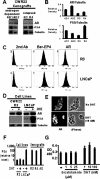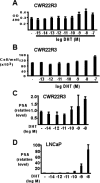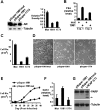Androgen receptor remains critical for cell-cycle progression in androgen-independent CWR22 prostate cancer cells
- PMID: 16877366
- PMCID: PMC1698802
- DOI: 10.2353/ajpath.2006.051047
Androgen receptor remains critical for cell-cycle progression in androgen-independent CWR22 prostate cancer cells
Abstract
The majority of prostate cancers (PCa) that relapse after androgen deprivation therapy (androgen-independent PCa) continue to express androgen receptor (AR). To study the functional importance of AR in these tumors, we derived androgen-independent CWR22 PCa xenografts in castrated mice and generated a cell line from one of these xenografts (CWR22R3). Similarly to androgen-independent PCa in patients, the relapsed xenografts and cell line expressed AR and were resistant to treatment with bicalutamide. However, expression of the AR-regulated PSA gene in the CWR22R3 cell line was markedly decreased compared to the relapsed xenografts in vivo. Transfections with androgen-regulated reporter genes further indicated that the cells lacked androgen-independent AR transcriptional activity and were not hypersensitive to low androgen concentrations despite constitutive activation of the Erk/MAP kinases. Nonetheless, AR remained essential for androgen-independent growth because retroviral shRNA-mediated AR down-regulation resulted in marked long-term growth suppression. This was associated with increased levels of p27(kip1) and hypophosphorylation of retinoblastoma protein but not with decreases in D-type cyclin levels or MAP kinase activation. These results reveal a potentially critical function of AR in androgen-independent PCa that is distinct from its previously described transcriptional or nontranscriptional functions.
Figures








Similar articles
-
Vav3, a Rho GTPase guanine nucleotide exchange factor, increases during progression to androgen independence in prostate cancer cells and potentiates androgen receptor transcriptional activity.Mol Endocrinol. 2006 May;20(5):1061-72. doi: 10.1210/me.2005-0346. Epub 2005 Dec 29. Mol Endocrinol. 2006. PMID: 16384856
-
Ligand-independent activation of the androgen receptor by the differentiation agent butyrate in human prostate cancer cells.Cancer Res. 2000 Oct 15;60(20):5825-31. Cancer Res. 2000. PMID: 11059779
-
Prolonged androgen receptor loading onto chromatin and the efficient recruitment of p160 coactivators contribute to androgen-independent growth of prostate cancer cells.Prostate. 2008 Dec 1;68(16):1816-26. doi: 10.1002/pros.20849. Prostate. 2008. PMID: 18780293
-
Androgen action in the prostate gland.Minerva Urol Nefrol. 2012 Mar;64(1):35-49. Minerva Urol Nefrol. 2012. PMID: 22402316 Review.
-
The role of the androgen receptor in the development of prostatic hyperplasia and prostate cancer.Mol Cell Biochem. 2003 Nov;253(1-2):89-101. doi: 10.1023/a:1026057402945. Mol Cell Biochem. 2003. PMID: 14619959 Review.
Cited by
-
Androgen receptor functions in castration-resistant prostate cancer and mechanisms of resistance to new agents targeting the androgen axis.Oncogene. 2014 May 29;33(22):2815-25. doi: 10.1038/onc.2013.235. Epub 2013 Jun 10. Oncogene. 2014. PMID: 23752196 Free PMC article. Review.
-
Mechanisms mediating androgen receptor reactivation after castration.Urol Oncol. 2009 Jan-Feb;27(1):36-41. doi: 10.1016/j.urolonc.2008.03.021. Urol Oncol. 2009. PMID: 19111796 Free PMC article. Review.
-
Endothelial cells enhance prostate cancer metastasis via IL-6→androgen receptor→TGF-β→MMP-9 signals.Mol Cancer Ther. 2013 Jun;12(6):1026-37. doi: 10.1158/1535-7163.MCT-12-0895. Epub 2013 Mar 27. Mol Cancer Ther. 2013. PMID: 23536722 Free PMC article.
-
20(S)-25-methoxyl-dammarane-3beta, 12beta, 20-triol, a novel natural product for prostate cancer therapy: activity in vitro and in vivo and mechanisms of action.Br J Cancer. 2008 Feb 26;98(4):792-802. doi: 10.1038/sj.bjc.6604227. Epub 2008 Feb 5. Br J Cancer. 2008. PMID: 18253123 Free PMC article.
-
Mouse prostate cancer cell lines established from primary and postcastration recurrent tumors.Horm Cancer. 2010 Feb;1(1):44-54. doi: 10.1007/s12672-009-0005-y. Horm Cancer. 2010. PMID: 20631921 Free PMC article.
References
-
- Gelmann EP. Molecular biology of the androgen receptor. J Clin Oncol. 2002;20:3001–3015. - PubMed
-
- Feldman BJ, Feldman D. The development of androgen-independent prostate cancer. Nature Rev Cancer. 2001;1:34–45. - PubMed
-
- Balk SP. Androgen receptor as a target in androgen-independent prostate cancer. Urology. 2002;60:132–138. - PubMed
-
- Joyce R, Fenton MA, Rode P, Constantine M, Gaynes L, Kolvenbag G, DeWolf W, Balk S, Taplin ME, Bubley GJ. High dose bicalutamide for androgen independent prostate cancer: effect of prior hormonal therapy. J Urol. 1998;159:149–153. - PubMed
-
- Small EJ, Halabi S, Dawson NA, Stadler WM, Rini BI, Picus J, Gable P, Torti FM, Kaplan E, Vogelzang NJ. Antiandrogen withdrawal alone or in combination with ketoconazole in androgen-independent prostate cancer patients: a phase III trial (CALGB 9583). J Clin Oncol. 2004;22:1025–1033. - PubMed
Publication types
MeSH terms
Substances
Grants and funding
LinkOut - more resources
Full Text Sources
Other Literature Sources
Medical
Research Materials
Miscellaneous

